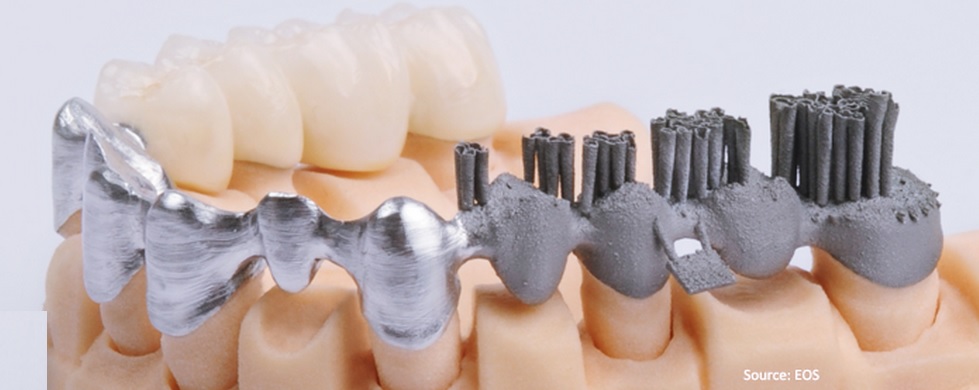See how dentistry is benefiting from metal 3D Printing

This EOS image shows the progression from 3D Printed framework, to polished part, and then finally veneered finished product. Note the rectangular tracking tag that holds the serial number identifying each part.
Additive Manufacturing is used to produce a wide array of functional parts. One of the most successful large scale implementations of Additive Manufacturing is metal 3D printed dental parts. This see’s patient specific bridges, crowns, and partial dentures printed using bio-compatible cobalt chrome powder. Direct Metal Laser Sintering (DMLS) is the main technology of choice for dental applications. 3D Systems, EOS Concept Laser, Renishaw, SLM Solutions & Realizer all sell metal 3D printers developed specifically for the dental industry. As many as 10,000,000 metal 3D printed dental parts are being made each year.
Why Metal 3D Printing Works for Dentistry
Metal 3D Printing is a good fit for Dentistry because:
- Each patient is different and each solution must be customised for that specific patient, allowing for best fit and comfort.
- Dental items are small and complex, aligning closely with the small build envelope of 3D Printing machines.
- Dental items are value dense, meaning that despite their small size they command high value. (This helps offset the large expense of metal 3D printers)
- Perhaps most importantly though, metal 3D Printing works in dentistry because it can vastly reduce the length and complexity of the manufacturing process.
Traditionally, metal frameworks for crowns are manufactured using ‘lost-wax casting’. Lost-wax casting is an ancient technique which involves a number of processes and highly skilled manual labour. The processes are outlined below:

It takes between two to three weeks for crowns to be produced using this highly convoluted traditional process.
3D Printing and digitalisation can drastically reduce the amount of time and number of steps involved in the manufacture of a crown. The new metal 3D Process is outlined below:

By moving to a more digital process and using 3D Printing it is now possible to shift from a production timescale of two to three weeks down to two to three days.
But what of the accuracy or quality of the work? By decreasing the production timescale do we decrease the quality? Well, a recent study published in The Journal of Advanced Prosthodontics found that “Dimensional accuracy, surface roughness and repeatability of metal 3D printing processes are within the required clinical guidelines of these prosthetics.”
Perhaps the most important reason for adopting the new 3D printing technology and methodologies however is that they are simply cheaper. Fresdental CEO Perez Carrio has stated that, “Compared to traditional, manual-production-based dental laboratories, digital manufacturing is extremely cost-efficient and offers enormous advantages in terms of quality. The cost of producing an average denture is around €20. With LaserCusing, it drops to slightly less than €10. Basically, we’re talking at least half the price.”
Who is developing the technology
Nearly all of the major manufacturers of metal 3D printers have developed a value proposition in the dental space:
LaserCusing is the name Concept Laser uses for its metal 3D printing technology. The company’s MLab Cusing line of machines can produce gold, cobalt chromium or titanium dental parts. The company has partnered with Dentaurum to offer its Remanium Star material as a powder for its metal machines.
UK Company Renishaw manufactures metal 3D printers such as the AM 250 which can be purchased directly. In addition, Renishaw also has a service called Renishaw Laser PFM which they use to develop their own dental implants. The company also offers a service where 3D printing is combined with milling for abutments.
Realizer has partnered with alloy company Progold to make gold alloys for dental and other applications.
SLM Solutions offers a Co Cr powder for dental use on its machines.
Sisma is a new entrant with its MySint system for gold.
3D Systems has a special Dental version of its ProX metal 3D printer.
EOS has a Cobalt Chrome SP2 material for dental and reports that its systems can make “450 units at low cost within 24 hours” and that “up 80,000 units can be produced each year” on one machine.
Companies using 3D printers to manufacture dental parts include family owned German company Bego. Bego is a leader in the field offering services for dentists and labs as well as having its own Wirobond C+ material. Other companies active in metal 3D printing for dental are Heraeus Kultzer’s Cara & LAC Service in Germany, Sineldent in Spain and DL Dental Labor in Turkey.
Future of Dental Metal 3D Printing
Metal 3D printing offers an exciting value proposition for dentists and patients a like; short production times, low costs, and high quality. We therefore expect to see metal 3D printing disrupt traditional metal dental implant manufacturing. However, one factor which may limit this future growth is the rising demand for ceramic dental implants. Ceramic implants, using materials such as Zirconia, are in some ways more aesthetically pleasing. Often they are not as strong as the metal alternative, but the aesthetic benefits are seen by some dentists as more important than the functional considerations. Currently ceramic dental prosthetics can only be made using CNC processes… 3D Printing of ceramic implants… now that would be interesting!